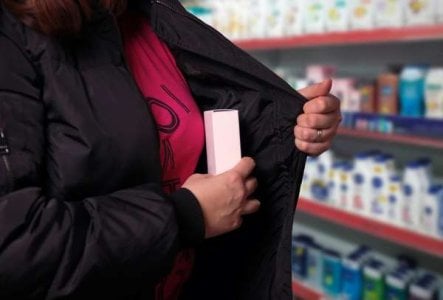Rising costs, rising crimes: Shoplifting among average Aussies surges amidst economic strain
- Replies 21
In a concerning trend reflecting the pressures of rising living costs, incidents of shoplifting are on the rise, leaving authorities grappling with a surge in petty crime.
Recent reports have highlighted the plight of everyday Australians resorting to illegal means to make ends meet, shedding light on the broader socioeconomic challenges facing communities across the country.
As families struggle to cope with mounting financial pressures, the increase in thefts underscores the urgent need for support and intervention to address underlying economic disparities and ensure the safety and security of businesses and consumers.
As grocery bills and rent payments soar to record highs, a concerning trend has emerged: an increase in shoplifting incidents, with a startling 30 per cent rise in one state over the past year.
According to the police, this is a ‘trend that is expected to continue’.
South Australia, in particular, became a focal point for this issue, with a staggering 1,455 shoplifting offences reported in March alone.
While this number slightly decreased from the 1,721 offences in January, it's still alarmingly high.

Retailers sounded the alarm in August, declaring shoplifting to be ‘out of control’ in parts of the state.
In a single day in April, during a major police operation at Adelaide's bustling Rundle Mall, 48 individuals were apprehended for shoplifting.
This nationwide dilemma is deeply rooted in a ‘range of socio-economic factors’. The trend of concern is ‘not confined to South Australia’; however, authorities across the state are dedicating significant resources to manage the situation.
‘In SA, police have been working proactively with the retail sector and individual businesses in the city that have been frequently targeted to reduce the harm caused by recidivist offenders,’ Police Commissioner Grant Stevens stated.
‘This significant factor has contributed to businesses increasing their reporting which has in turn assisted police in combating the problem.’
What's particularly shocking is the demographic of those caught in the act.
According to Josh Peak from the Shop, Distributive and Allied Employees’ Association, it's not just the stereotypical image of organised crime rings or seasoned criminals; it's average 'mum and dad' shoplifters.
‘We continue to see the impact of organised crime and gangs…but we're seeing a lot of theft from people whom you could categorise as mum and dads. So it is a worry,’ he said.
In the last year alone, nearly 19,000 people have been caught shoplifting in South Australia, marking a 29 per cent increase, according to police data.
Retail staff have echoed this sentiment, observing that a significant portion of the culprits are not the usual suspects, but rather ordinary parents.
With police sounding the alarm, Commissioner Stevens warned that the situation may deteriorate before any improvement is seen, at least in terms of the data.
‘While such reporting elevates the statistics for shop theft, it gives a much clearer picture of the extent of the problem,’ he explained.
‘This increased reporting trend is expected to continue and will further elevate the statistics.’
As instances of shoplifting increase amidst growing concerns over the cost of living, initiatives like the 'If You See Something, Say Something' campaign are gaining traction, highlighting the importance of community involvement in reporting retail crimes.
This collaborative effort between law enforcement and the public aims to address the rise in petty thefts and promote a safer shopping environment.
By encouraging individuals to speak up when they witness suspicious behaviour, the campaign empowers communities to play an active role in combating crime and safeguarding local businesses.
 Have you noticed an increase in shoplifting in your area? How are you coping with the rising cost of living? We encourage you to share your experiences and thoughts on this troubling trend in the comments below.
Have you noticed an increase in shoplifting in your area? How are you coping with the rising cost of living? We encourage you to share your experiences and thoughts on this troubling trend in the comments below.
Recent reports have highlighted the plight of everyday Australians resorting to illegal means to make ends meet, shedding light on the broader socioeconomic challenges facing communities across the country.
As families struggle to cope with mounting financial pressures, the increase in thefts underscores the urgent need for support and intervention to address underlying economic disparities and ensure the safety and security of businesses and consumers.
As grocery bills and rent payments soar to record highs, a concerning trend has emerged: an increase in shoplifting incidents, with a startling 30 per cent rise in one state over the past year.
According to the police, this is a ‘trend that is expected to continue’.
South Australia, in particular, became a focal point for this issue, with a staggering 1,455 shoplifting offences reported in March alone.
While this number slightly decreased from the 1,721 offences in January, it's still alarmingly high.

Australia's cost of living crisis has fueled a 30 per cent surge in shoplifting in South Australia over the past year. Credits: Shutterstock
Retailers sounded the alarm in August, declaring shoplifting to be ‘out of control’ in parts of the state.
In a single day in April, during a major police operation at Adelaide's bustling Rundle Mall, 48 individuals were apprehended for shoplifting.
This nationwide dilemma is deeply rooted in a ‘range of socio-economic factors’. The trend of concern is ‘not confined to South Australia’; however, authorities across the state are dedicating significant resources to manage the situation.
‘In SA, police have been working proactively with the retail sector and individual businesses in the city that have been frequently targeted to reduce the harm caused by recidivist offenders,’ Police Commissioner Grant Stevens stated.
‘This significant factor has contributed to businesses increasing their reporting which has in turn assisted police in combating the problem.’
What's particularly shocking is the demographic of those caught in the act.
According to Josh Peak from the Shop, Distributive and Allied Employees’ Association, it's not just the stereotypical image of organised crime rings or seasoned criminals; it's average 'mum and dad' shoplifters.
‘We continue to see the impact of organised crime and gangs…but we're seeing a lot of theft from people whom you could categorise as mum and dads. So it is a worry,’ he said.
In the last year alone, nearly 19,000 people have been caught shoplifting in South Australia, marking a 29 per cent increase, according to police data.
Retail staff have echoed this sentiment, observing that a significant portion of the culprits are not the usual suspects, but rather ordinary parents.
With police sounding the alarm, Commissioner Stevens warned that the situation may deteriorate before any improvement is seen, at least in terms of the data.
‘While such reporting elevates the statistics for shop theft, it gives a much clearer picture of the extent of the problem,’ he explained.
‘This increased reporting trend is expected to continue and will further elevate the statistics.’
As instances of shoplifting increase amidst growing concerns over the cost of living, initiatives like the 'If You See Something, Say Something' campaign are gaining traction, highlighting the importance of community involvement in reporting retail crimes.
This collaborative effort between law enforcement and the public aims to address the rise in petty thefts and promote a safer shopping environment.
By encouraging individuals to speak up when they witness suspicious behaviour, the campaign empowers communities to play an active role in combating crime and safeguarding local businesses.
Key Takeaways
- The cost of living crisis in Australia has led to a spike in shoplifting, with a 30 per cent rise in theft in South Australia in a year.
- Everyday Aussies, including 'mum and dad' shoplifters, are turning to theft amidst high rental costs and allegations of price gouging by supermarkets.
- South Australia police increased efforts to work with retailers to address the significant rise in shoplifting offences.
- Despite a decrease in offences from January to March, authorities expect the shoplifting trend to continue and reporting to escalate, further elevating the crime statistics.







